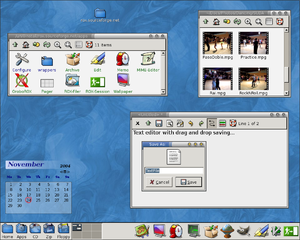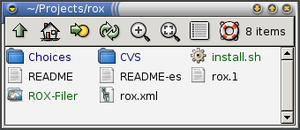ROX Desktop

A screenshot of the ROX desktop
|
|
| Stable release |
2.11 / 9 October 2011
|
|---|---|
| Repository | github |
| Development status | Dormant |
| Written in | C, Python, GTK+ |
| Operating system | Unix-like |
| Type | Desktop environment |
| License | GNU General Public License |
| Website | rox |

Screenshot of ROX-Filer
|
|
| Original author(s) | Thomas Leonard |
|---|---|
| Stable release |
2.11 / November 10, 2011
|
| Repository | github |
| Operating system | Unix-like |
| Type | File manager |
| License | GNU General Public License |
| Website | rox |
The ROX Desktop is a graphical desktop environment for the X Window System. It is based on the ROX-Filer which is a drag and drop spatial file manager. It is free software released under the GNU General Public License. The environment was inspired by the user interface of RISC OS. Programs can be installed or removed easily using Zero Install.
The ROX Desktop is a desktop environment based on the ROX-Filer file manager. Files are loaded by dragging them to an application from the filer, and saved by dragging back to the filer. Applications are executable directories, and are thus also installed (copied), uninstalled (deleted), and run through the filer interface. ROX has a strong link with Zero Install, a method of identifying and executing programs via a URL, to make software installation completely automatic.
It is inspired by the user interface of RISC OS (not to be confused with RISC/os). The name "ROX" comes from "RISC OS on X". The project was started by Thomas Leonard as a student at University of Southampton in 1999 and is still led by him in 2012.
The desktop uses the GTK+ toolkit, like the GNOME and Xfce desktops. The design focuses on small, simple programs using drag-and-drop to move data between them. For example, a user might load a compressed file into a spreadsheet from the web by dragging the data from the web browser to the archiver, and from there into the spreadsheet. A program would be installed in the same way, by dragging the archive from the web to the archiver, and from there to the applications directory in the filer.
...
Wikipedia
